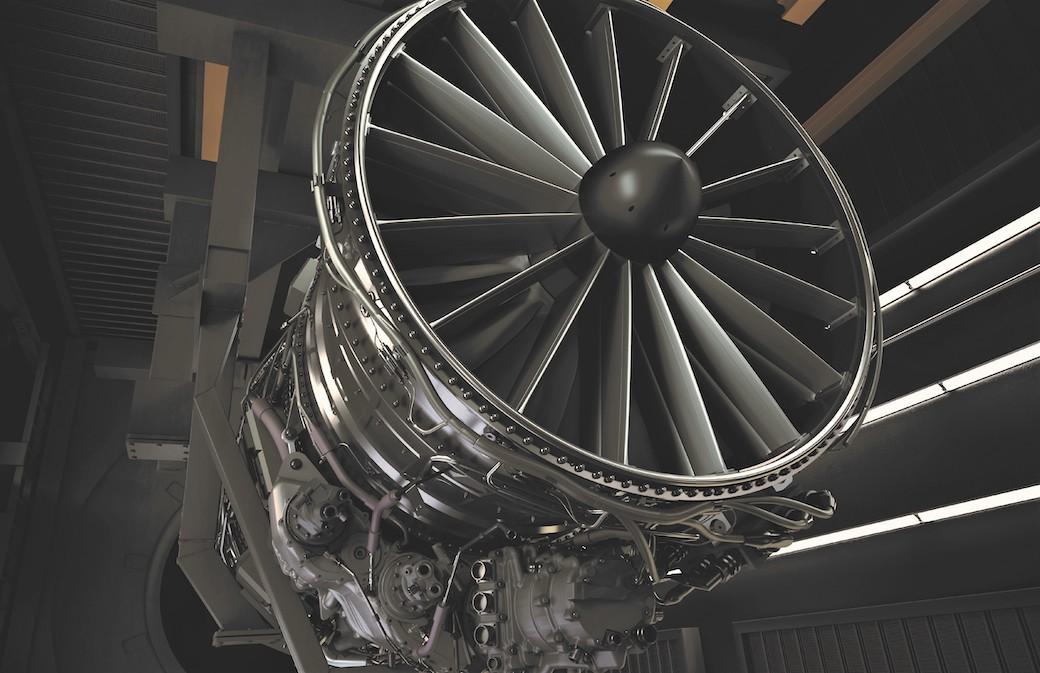
COLORADO SPRINGS—GE Aerospace is beginning design work for a production standard version of the XA100 adaptive engine for the Lockheed Martin F-35 with the intent of integrating the three-stream powerplant into the fighter by 2028.
Internally designated by GE as a Design and Manufacturing Advancement (DMA) program, the effort already involves around 400 engineers and follows a $203 million contract extension to the U.S. Air Force’s Adaptive Engine Transition Program (AETP), which was awarded late last year. The extension was funded after AETP engine testing was completed in August 2022.
The start of design work on a production configuration XA100 variant comes as GE and incumbent F-35 engine supplier Pratt & Whitney wait to see if an engine replacement program will be included in the defense budget for fiscal 2024. Air Force Secretary Frank Kendall has indicated a decision could be made as part of the new budget, but cautioned the price tag for developing and installing an adaptive engine could run to more than $6 billion.
Pratt & Whitney is testing its own adaptive engine under AETP dubbed the XA101. But the company argues that improvements it has designed for the existing F135 powerplant, under its enhanced engine package (EEP) proposal, mitigate the need for an expensive wholesale replacement effort.
Meanwhile, both GE and Pratt are developing prototype variable-cycle engine contenders for the Air Force’s Next Generation Air Dominance (NGAD) fighter under Next Generation Adaptive Propulsion (NGAP) engine program contracts awarded last summer. Propulsion integration-related NGAP contracts were also issued to airframes Boeing, Lockheed and Northrop Grumman.
“We are looking forward to seeing a decision in the president’s budget that will come out here in the next few weeks. All eyes are on that for sure,” says David Tweedie, general manager of Advanced Combat Engines at GE Edison Works. “The Air Force now knows that if they make the big decision and the big bet to really fully modernize the F-35 with AETP capability that they can count on industry to deliver. I think that’s the piece that we brought to the table over these last few years.”
Tweedie says current geopolitical events also indicate the need for long-term capability improvements in the F-35 “that only AETP solutions can provide.” The use of the variable-cycle design, which ducts additional bypass flow for more endurance and thermal management or greater thrust, could enable “up to a 30% range increase as well as a 20% kinematic capability improvement,” he says.
Other expected benefits include “double thermal-management capacity, as well as providing durability enhancements and readiness improvements that the warfighter needs,” Tweedie says. “We really think AETP clearly is the solution, and we are ready to meet that challenge and continue to move forward.”
The intent with the DMA program “is to continue us on the path to be able to provide this capability into the F-35 seamlessly by 2028,” Tweedie explains. The program includes “a range of activities associated with doing the design that we always planned between the prototyping phase, the final product requirements sets and product configuration.”
GE also continues to “work very closely with Lockheed Martin,” he notes. “It’s been a decade-long partnership on the AETD and AETP programs to ensure these adaptive-cycle engines can integrate seamlessly into the F-35 and are optimized not for engine performance but for the overall capability of the platform,” says Tweedie, referring to the Adaptive Engine Technology Development program that preceded AETP.
Two flight-weight XA100s were tested under AETP with evaluations of the second engine wrapping up at the Air Force’s Arnold Engineering Development Complex (AEDC) in Tennessee in August 2022. Data from the teardown of the first XA100 and additional systems-level data from the second engine are being incorporated into the design of the production version, Tweedie says.
“We believe that the XA100 program, whether commercial or military, represents the most rigorous prototyping efforts ever conducted to the most robust set of technical requirements. And as we see the requirements evolve between the prototype AETP phase to EMD (engineering and manufacturing development), there’s been relative stability in those requirements,” Tweedie says. “So we built something to a rigorous set of requirements that worked incredibly well and now we see requirements stability in the next phase. We rarely are in this kind of position where we have this kind of data in hand at the start of a program.”
The F-35 adaptive re-engining program is targeted mainly at the conventional F-35A and C models but also may involve the F-35B short-takeoff-and-vertical-landing version—an integration study for which GE conducted last year with the F-35 Joint Program Office (JPO), Lockheed and Rolls-Royce. But Tweedie says GE believes this element of the re-engining effort would be viewed “as a separate activity if the Air Force moved forward with an A model that they could easily leverage into a C model.”






Comments